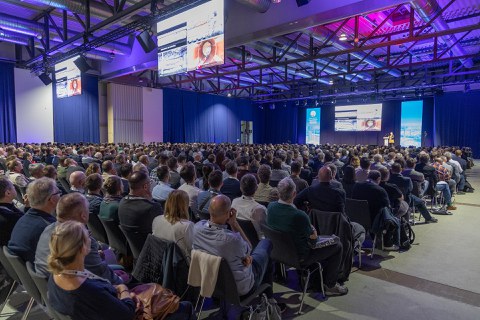Mar 25, 2025
Successful 34th edition of the Dresden Bridge Building Symposium and presentation of the German Bridge Construction Award 2025
Dresden, March 20, 2025 - In its 34th edition, the Dresden Bridge Building Symposium has once again established itself as one of the most important specialist events in the field of bridge and civil engineering. Experts from science, industry and administration came together at Messe Dresden at the invitation of the Institute of Concrete Structures at TU Dresden to discuss new developments, innovative solutions and current challenges in bridge construction.
A special highlight was the award ceremony for the German Bridge Building Prize 2025, which took place the evening before. Outstanding engineering achievements in bridge construction were honored in the presence of the Federal Minister of Transport, Dr. Volker Wissing.
The event kicked off with a combined lecture on the highly topical subject of older prestressed concrete bridges. At the beginning, Prof. Dr.-Ing. Gero Marzahn (Federal Ministry of Transport and Digital Infrastructure, Bonn) spoke about the challenges of maintaining them. Prof. Dr.-Ing. Steffen Marx (TU Dresden, Institute of Concrete Structures) then reported on the collapse of the Carola Bridge in Dresden and the resulting consequences for bridge construction.
This was followed by a practical contribution by Christina Fritsch, M. Sc. (MKP GmbH, Weimar), who presented current experiences from structural investigations under the title "Measuring instead of estimating" and explained how real measured values can influence calculation results. Prof. Dr.-Ing. Martin Mensinger (TU Munich) then presented current research results on fracture mechanics approaches for the safe estimation of the service life of old steel railroad bridges. When dealing with our existing bridges, the topic of monitoring is rapidly gaining in importance. DI Dr. Dominik Prammer (ASFINAG Bau Management GmbH, Vienna) and Dipl.-Ing., Dr.-Ing., MBA Vazul Boros (AIT Austrian Institute of Technology, Vienna) presented an innovative approach to bridge monitoring - namely with the help of satellite data and fiber optic sensors.
At the 34th DBBS, however, there was also a lot of talk about new bridge construction. The range here was extraordinarily wide. Dipl.-Ing. Bartlomiej Halaczek (Knight Architects, London), for example, addressed the societal responsibility for sustainability in bridge construction in his presentation "Building bridges for the traffic turnaround - why empathy counts in civil engineering" and focused on what he considers to be the "most demanding bridge users" - pedestrians. Prof. Dr.-Ing. habil. Reinhard Pohl (TU Dresden) spoke about the influence of hydraulic engineering factors that need to be taken into account when designing, building and operating bridges, before Dipl.-Ing. Andreas Keil (sbp SE, Stuttgart) presented the new Danube Bridge Linz, a suspension bridge that he rightly described as "a special bridge for a special place".
Pioneering ideas for modular construction with a high degree of prefabrication were presented by Prof. Dr.-Ing. Holger Flederer and Prof. Dr.-Ing. Thomas Bösche (HTW Dresden) and O.Univ.Prof.em. Dipl.-Ing. Dr.-Ing. Johann Kollegger and Dipl.-Ing. Franz Untermarzoner (Vienna University of Technology). The former presented various concepts that allow, for example, the rapid replacement of road bridges. The problem-free dismantling of a complete bridge structure was also demonstrated using a real-life example. This is now in storage and awaits its next use. The guests from Vienna provided exciting insights into the progress that has been made in recent years in the further development of the LT bridge construction method. Presentations on the planning status of a major bridge construction project in Hamburg - the replacement of the Süderelbe railroad overpass - (Dipl.-Ing. Stefanie Heser, DB InfraGO AG, Hamburg), on the design of the Ilmenau bridge in Lüneburg, taking into account new BEM-ING regulations (Dipl.-Ing. Thomas Bussler from WTM Engineers GmbH, Hamburg), the presentation of a 1-kilometre-long temporary bridge for the Südschnellweg Hannover by Dr.-Ing.Ing. Waldemar Krakowski (Emch+Berger, Hanover) and Dipl.-Ing. Lothar Weinreich (Niedersächsische Landesbehörde für Straßenbau und Verkehr) as well as a presentation on the dismantling of the longest cable-stayed bridge in Germany, which held numerous unforeseeable surprises (presented by Daniel Haussner, M. Eng. and Dr. Bernd Püstow, HOCHTIEF Infrastructure GmbH, Essen), rounded off the technical program.
The 34th DBBS also featured two special program items. One highlight was the award ceremony for the student competition "Design of a resource-efficient pedestrian and cycle bridge at Südpark in Dresden", supervised by Prof. Dr.-Ing. In addition, Ruben Langer, civil engineer and slackliner, took the guests into a completely different world. With the longest fall-free ascent of a highline at the time (2130 m at a height of up to 600 m), he gave an exciting example of a bridge in its most minimalist form.
The 34th Dresden Bridge Building Symposium offered participants valuable specialist information, practical insights and an excellent platform for exchanging views on current developments in bridge construction. The adjoining trade exhibition with over 90 participating companies covering almost all aspects of bridge construction was very well attended and was used for networking. The presentation of the German Bridge Construction Award 2025 the evening before underlined the outstanding achievements of engineers in this important area of infrastructure development.
The 35th edition of the symposium in 2026 is already awaited with great anticipation. Presentation proposals can be submitted until August 22, 2025.







































